Well, if you are a chicken, then having chicken legs is a very good thing. But in general, having chicken legs as a human is not a flattering term – as one anonymous person on the internet put it . . .
“(chicken legs) – are really skinny (probably in comparison with your body), scrawny, maybe even dry or it looks like you just plucked your hair and the stubs are growing again.” ~ https://answers.yahoo.com/question/index?qid=20110212091222AA2FWPs
That just about covers it. Chickens do look like they are walking on legs too skinny for their bodies; their legs are often dry and dirty, and they are scaly. But to a chicken, those legs and feet are very important and are a very powerful tool.
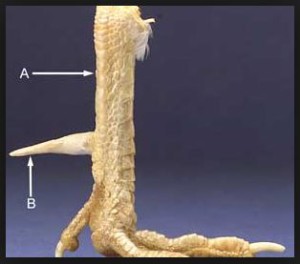
The chicken leg is made up of thigh, hock, shank, and foot. The foot has three long toes, one short toe, and claws. Male chickens have an extra large claw on the shank, about an inch above the foot, called the spur. The thigh and hock (joint) are covered in feathers, and the shaft and foot are scaly. The male spur is used for fighting other males and can be very large and dangerous; it appears on the male at about two years of age and can grow very long.
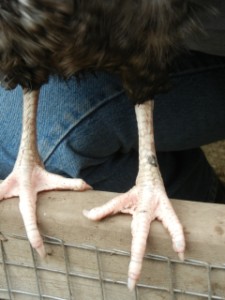
The chicken foot is similar to other bird feet, with three large toes pointing forward and one small toe pointing backwards,. The claws are sharp and grow constantly for scratching in the dirt. The underside of the chicken foot is padded with thick bumpy skin for gripping.
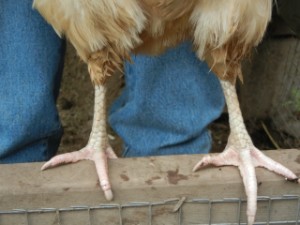
Chickens have many uses for their feet; getting from one place to another in a variety of motions, gripping the roost while sleeping, scratching the head and neck when one has an itch, fighting (mostly roosters), and scratching up leaf debris and dirt looking for food. This last use has caused some strife in the household as Andrea complains about the chickens scratching up the yard plants as Denise tries to convince her that it is not that bad.
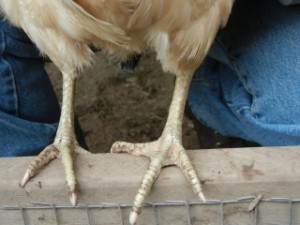
The skin color of legs and feet can be very different from breed to breed. Our hens’ leg colors are different from one another – see photos. Excuse the dirty feet, the hens forgot to wash up for the photos.
Happy Chickens
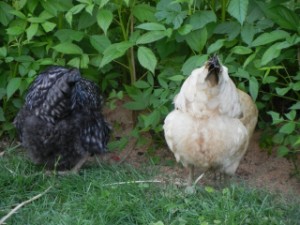
The spring plants have matured in the yard enough to let the chickens have almost full run again. Denise and Andrea spent an afternoon fencing off the vegetables areas, berry plants, and flowering plants that might be tempting to the chickens. And since they have not had access to one side of the yard for some time, there is a bounty of slugs to munch on, and their favorite dirt bathing area is available to them again.
Heart Stopper
Henny gave Denise quite the scare the other day. Denise went out to the coop to close it up for the night and could not find Henny, she was not on the roost. After using a flashlight Denise discovered her in the nest box and she did not appear to be moving, nor did she appear to be breathing. Denise opened the back of the nest box and reached in and shook Henny gently. Henny seemed stiff and did not make any noise; Denise’s heart was beating hard until she leaned down and shone a flashlight into the eyes of a hen that did not look very happy to be woken up in such a manner. Still a little concerned Denise went to bed and thought about what could be wrong with Henny. Was she having troubles laying an egg? None of the hens have ever stayed on the nest overnight and they always lay their eggs by mid-afternoon. It then occurred to Denise that it was spring, that time of year when animals feel the need to breed and have babies. Oh, oh was Henny becoming broody and wanting to sit on eggs? Will she want to be on the nest for the 21 days it takes to hatch chicks?
The next morning Henny was still on the nest. Broodiness is physical as well as behavioral. Hens actually get a warming to their breast area, thus helping them to keep eggs at body temperature for development. Some hens actually pull their breast feathers out so the eggs are in direct contact with the skin. There are several ways to try and break the broodiness of hens when they do not have fertile eggs to hatch;
1. Don’t let them near the nesting boxes – this will not work for Denise and Andrea’s set-up.
2. Put them in a wire cage so that cool air gets to their undersides and cools down the warm patch. Denise is not going to do that to her chickens.
3. Put ice cubes in the nest, those achieving the same result as number 2. Denise does not want a wet nest box as the ice cubes melt.
4. Keep removing the eggs and removing the chicken from the nest. This is the option that Denise chose.
To remove the eggs from Henny the next day, Denise put a glove on, just in case Henny was cranky about it, and gentle pushed Henny over to get the eggs out. Yes, Henny growled at Denise and pecked her hand a few times, but over all did not put up a lot of fuss. Henny still refused to leave the nest, so Denise picked her up and took her outside to the food and other two hens that were busy eating. Well either it was a fluke or the broodiness was nipped early enough, because Henny has not shown signs of broodiness again, in a week. Denise will be watching for the behavior and the signs of brooding in all her hens this spring.